 |
| |
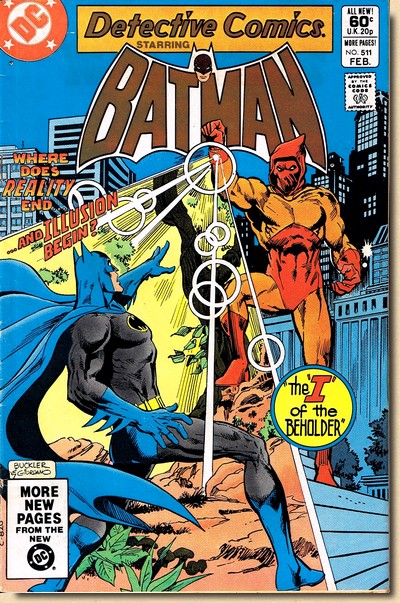 |
|
DETECTIVE
COMICS #511
(FEBRUARY
1982)
BATMAN
'TWIXT REALITY AND ILLUSION
ADRIENNE ROY COLOURS THEM BOTH
"The 'I'
of the Beholder"
(27 pages)
Cover
pencils - Rich Buckler
Cover inks - Dick Giordano
Cover colouring - Anthony Tollin
Story - Gerry
Conway
Art - Don Newton
Inks - Frank Chiaramonte
Colours - Adrienne Roy
Lettering - John Costanza
Editor - Dick Giordano
Second
feature - none
Letters page
- "Batcave" (1 page)
|
|
|
| |
PLOT SUMMARY
Following a
heated election campain councilman Arthur Reeves is
defeated by Hamilton Hillin Gotham City's mayoral
election. Robin is thrilled and feels Reeves got what he
deserved for his smear campaign against Batman, but Bruce
Wayne is more cautious in his verdict as he feels that
the way Reeves lost - with the exposure of
"his" Batman photographs as fakes - looks
almost as though someone deliberately set Reeves up for
the fall...
|
| |
| At the same time, at the
Raytona Raceway, three drunken men poke fun at a
hooded figure who calls himself 'Mirage'. On his
wrist, a gem begins to sparkle, and next the
three men find themselves in the midst of a
jungle face to face with a wild lion... Reality is
twisted again by Mirage as he picks up the cash
receipts from today's race, making the cashier
believe he's somewhere in the wilderness.
Back
outside by the racetrack, photographer Vicki Vale
finds herself subjected to Mirage's reality
shifting but - photographer's instinct - keeps on
taking pictures of what she perceives to be a
giant ice bear amidst a frozen landscape.
However, when she has her pictures developed,
none show what she believed to see at the
racetrack.
At
the newspaper editor's office, Bruce Wayne
overhears the conversation Vicki Vale has with
her employer, and her account of the mysterious
events at the racetrack arouse his interest -
whilst he also muses about the fact that as soon
as Selina Kayle walks out of his life, Vicki Vale
seemingly walks back in.
|
|
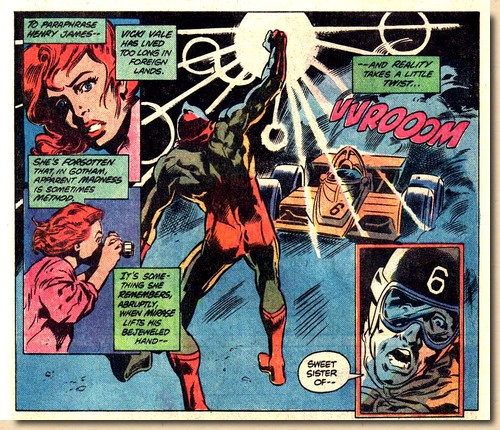 |
|
| |
| Meanwhile,
Dick Grayson has enrolled at Gotham University and visits
the campus, where he literally walks into a most
impressive female named Dala (who will soon be revealed
to be a major threat for the Dynamic Duo). Later that evening,
at the Wayne Foundation, Bruce Wayne is working late to
sort things back into order again after Poison Ivy had
previously enacted a mind control scheme over the board
of directors, but seeing the Bat-Signal light up, Bruce
ushers Lucius Fox home, telling him that he will make an
important announcement to the board tomorrow. Elsewhere
in town, councilman Reeves storms into the office of the
person who gave him the fake photographs claiming to
prove Batman's secret identity - and finds that said
person is none other than "Boss" Rupert Thorne.
|
| |
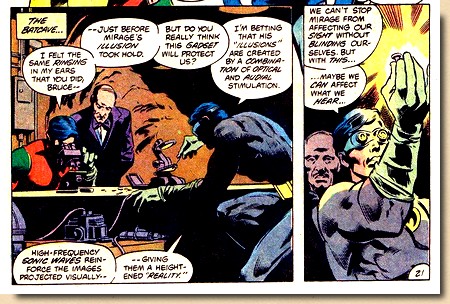
|
|
The
Bat-Signal call has to do with
Mirage, who has since used his
power to broadcast incredibly
realistic illusions for
committing further thefts. As
Dick Grayson attends a publicity
show staged by a fashion
designer, he becomes witness to
yet another Mirage robbery - and
swings into action as Robin, the
Teen Wonder. However, he
finds that he cannot stand up to
Mirage and his illusions, and
together with Batman, who also
experienced illusional
sensations, analyzes the facts
back at the Batcave.
Arriving at
the conclusion that Mirage's
illusions are created by audio
und visual wave stimulations,
blocking their hearing for the
next encounter seems the best way
to take Mirage out.
|
|
|
|
| |
| Batman's
tactics prove their worth and during his next robbery,
Mirage is brought down by the Darknight Detective -
however, only partly due to Batman's deafening device,
which receives a blow during the fight with Mirage and is
smashed to pieces. |
| |
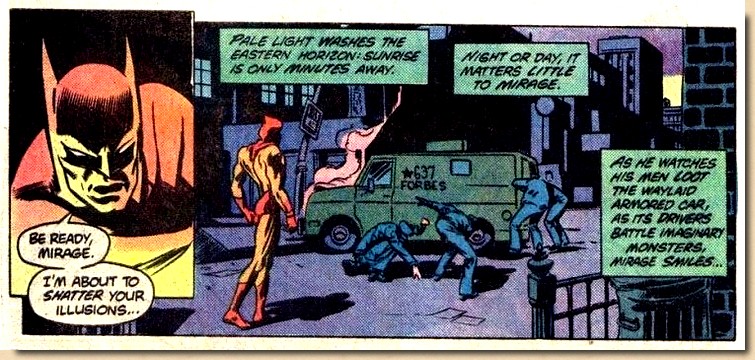
|
| |
| In the end,
it is Batman's willpower and sheer determination which
have him - albeit now again unprotected against the
illusions created by Mirage - gain the upper hand. |
| |
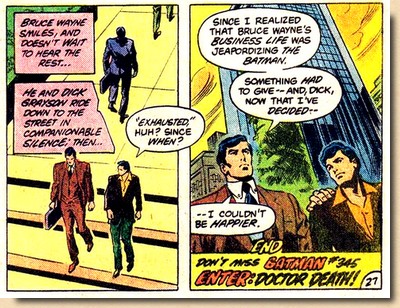
|
|
The next
morning, Bruce Wayne informs the
board of the Wayne Foundation
that he is stepping down as
chairman and appoints Lucius Fox
as his successor. This step, as
he later explains to Dick, became
necessary as "Bruce
Wayne's business life was
jeopardizing the Batman."

"DON'T
MISS BATMAN #345 - ENTER: DOCTOR
DEATH !"
|
|
|
|
| |
REVIEW & ANALYSIS
Whilst not
telling a truly classic Batman story, Detective
Comics #511 contains a whole heap of reading
interest, and Gerry Conway virtually fires on all
cylinders as he has Batman encounter a strange and
mysterious new foe, Bruce Wayne meet up with Vicki Vale
again, Dick Grayson being back on campus without quitting
his post as Teen Wonder and encountering a strangely
attractive woman, councilman Reeves discovering that his
downfall was manufactured by "Boss" Thorne, and
finally Bruce Wayne stepping down as head of the Wayne
Foundation and appointing Lucius Fox as his successor...
most certainly a tremendous lot of story and plot content
cum characterization. And it's a perfectly entertaining
read, too.
|
| |
| A number of incidents
occuring in Detective Comics #511 will
only reveal their true importance and meaning in
issues yet to come, and this is where Conway is
at his best, placing props all over the place and
setting up complex sub-plots for future
storylines. It is done with great perfection and
nestled within a completely smooth narrative. His
characterization is just as strong, as he has
Batman point out to Commissioner Gordon - who is
faced by a campaign pledge from the newly elect
mayor to have him replaced - that Gordon is more
of a fixture of Gotham City than the Caped
Crusader. And Don Newton delivers the perfect
visual rendition for this ponderous moment.
|
|
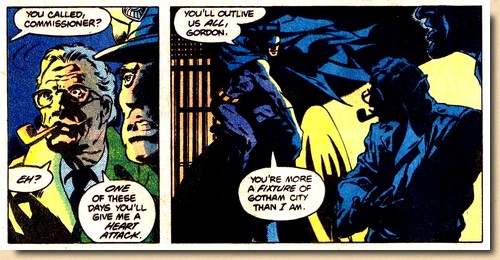 |
|
| |
| Gerry
Conway also provides us with a telling piece of Batman
characterization as the device he wears to block out the
sonic waves sent out by Mirage to create his illusions is
rendered useless during the fight. As the Darknight
Detective finds himself stripped of technological aid, he
falls back to his core strength: determination and
willpower. |
| |
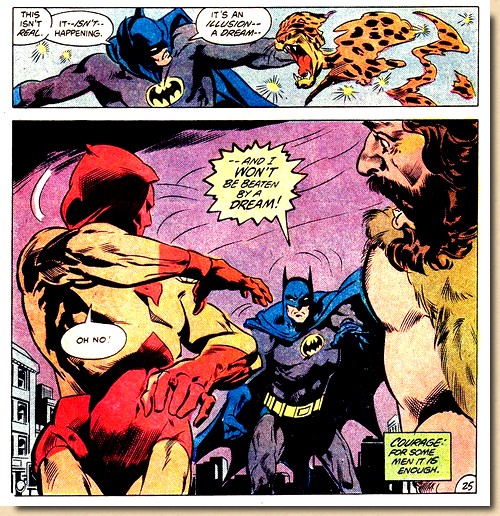
|
|
And although
it requires an incredible effort,
it works. Almost in a nutshell
Conway thus nicely sums up what
really makes Batman so special as
a persona and a pop culture
ideal: Batman could - stretching
the imagination juuuust a bit
more than usual - be real;
there's nothing superhuman about
Bruce Wayne, and Batman is the
product not of radioactivity or
magic or extraterrestrial doings,
but simply a conglomerate of
dedication, determination and
willpower (plus money, of
course). Don Newton
supplies the quality artwork
readers of previous issues have
come to expect from him, and his
renditions of night scenes in
general and the Batman in
specific are just absolutely
perfect.
VERDICT:
RECOMMENDED
READING -
interesting and solid story with
a whole web of multiple sub-plot
strands, all put together ever so
smoothly, and accompanied by
excellent Batman artwork

|
|
|
|
| |
FACTS & FIGURES
There is no
second feature in this issue due to the overlong Batman
story running for a a full 27 pages.
The
story contains concise indications with regard to the
location of Gotham City as the Raytona Racecourse is said
to be "across the river, in New Jersey".
Vicki
Vale was a regular Golden Age backup character but was
dropped by then newly appointed edior Julius Schwartz in
1964. She returned in Batman #344 (February
1982), and this is her first appearance in Detective
Comics since issue #320 (October 1963).
|
| |

Adrienne Roy c.2009
© 2011 TwoMorrows Publishing
|
|
Detective Comics
#511 is coloured by Adrienne Roy (who had
previously already provided the colouring
for Detective Comics #481-498
and #500-509), and as of this issue she
became the regular in-house colourist for
the title up until Detective Comics
#684 (April 1995), missing only issues
#554, #568, #579, #588 and #651 during
that entire run of 174 issues which
lasted for more than 13 years. Adrienne
Roy was born 28 June 1953, grew up in
Verona (New Jersey) and graduated from
William Paterson University (New Jersey)
as a Fine Artist. Her first contact with
comic books was through Marvel's Tomb
of Dracula, Sub-Mariner
and Conan (Eury, 2011). In 1976
Roy married Anthony Tollin and moved to
New York City, initially working as an assistant of
her husband before long-time colourist
Jack Adler gave Roy her first consignment
at DC with the cover of DC Special
Series #8. Adler and fellow colourist
Sol Harrison were considered by Roy
herself as her mentors during her first
years at DC (Eury, 2011).
She soon became a
fixture for the entire Batman line under
editor (and later DC President and
Publisher) Paul Levitz. Roy was the only
DC freelancer with her own desk in the
company’s Manhattan offices, and she
was the first colourist signed by DC to
exclusive, multi-year employment
contracts (Tollin, 2010).
|
|
|
| |
“Adrienne
combined the ability of a set designer to create
beauty with the ability of a lighting designer to
create drama and storytelling focus, and wrapped it
in a sweet professionalism. No wonder we editors
chose her again and again, keeping her on favorite
titles like Batman literally for decades.” (Paul
Levitz in Tollin, 2010)
|
| |
| Roy was also responsible for
the coloring on many other titles during that
time period (including The New Teen Titans,
Warlord, Weird War Tales and Madame
Xanadu) but is above all known for her work
on the Batman books, including a lengthy run on Detective
Comics which she started with issue #480 (Nov/Dec
1978). The typical comic book look -
up until the mid-1990s - of limited colours
displaying a rather washed-out appearance with
reduced contrast separation was due to two main
factors: the so-called "Subtractive
Primaries Colour Printing" or "Four
Colour Process" (CMYK for short), and the
fact that more often than not the paper used for
printing comics was of inferior quality; known as
newsprint, it was used primarily for its
low cost factor and its high absorbency, which
was well suited to rubber plates used on
high-speed offset presses (a job which DC
consigned to World Color Press in Sparta,
Illinois).
The
production process of newsprint paper results in
very short fibres and high levels of lignin,
which rapidly discolour and oxidise - in other
words: the paper used for comic books was hardly
ever actually white. The problem with this was -
subtractive colour printing works best when the
paper is white...
The
CMYK printing process produces the necessary
varying colors by applying the so-called subtractive
primaries Cyan (blue), Magenta
(purple) and Yellow. Mixing
yellow and cyan produces green colours, whilst
yellow mixed with magenta results in reds and
magenta with cyan in blues. Mixing equal amounts
of cyan, magenta and yellow in sufficient density
produces black, but in order to save ink and
decrease drying times black is used as the fourth
colour pigment for the so-called "key"
(hence the letter K) printing
plate, which prints the artistic detail of an
image (Ferry, 1921).
A
four-colour printing press therefore uses four
printing plates - one for each colour separation
- wrapped around a cylinder and inked with the
relevant colour. As paper passes through the
press, the cyan, magenta, yellow and black
separations are printed one on top of the other.
This can produce a wide range of colours by
combining different tints of the four inks as
colours are split into so-called "component
separations".
In
applying this system, a full red colour can be
described as being the result of 0% cyan, 100%
magenta, 100% yellow and 0% black, whereas a
medium blue separates as 100% cyan, 50% magenta,
0% yellow and 0% black. In the case of a
photographic image, each pixel can be separated
into percentages of the four CMYK components, but
the separations used for comic books up until the
1980s were much cruder (using only tones of 0%,
25%, 50%, 75% and 100%), leaving colourists such
as Adrienne Roy with a greatly reduced selection
of colours available (64, to be precise).
The
printed result was further hampered by the very
course dot grid which in some cases was
noticeable not only in close-up as "dotty
printing" and which produces the classic
Silver and Bronze Age "colour dots".
The necessary colour separations were done for
both Marvel and DC by the Chemical Color Plate
Corporation in Bridgeport CT.
As a
colourist, Adrienne Roy eceived quality
photostats of the original arwtork but reduced to
actual printing size (i.e. roughly two thirds the
size of the original artwork), which she would
then hand colour.
In
addition, Roy (like her fellow colourists) also
added codes for the colours used by referring to
the CMYK process (e.g. Y50C, which means 50%
yellow plus full cyan), which served to produce
the colour separations on rubylith acetate. These
overlays (one each for CMYK) then went to the
camera for the shoot plates.
This
process continued into the late 1990s before
computer colouring took over, although the better
quality paper used later allowed for a larger
range of colours and tones.
When computerized colors
arrived to comics, assignments to classic
colourists decreased substantially, and by the
year 2000 Roy had moved out of comics. Following
a short battle against cancer, Adrienne Roy
passed away in Austin TX on December 14th, 2010.
Adrienne
Roy's name has appeared on more Batman comic book
credits than anyone else except Bob Kane.
|
|
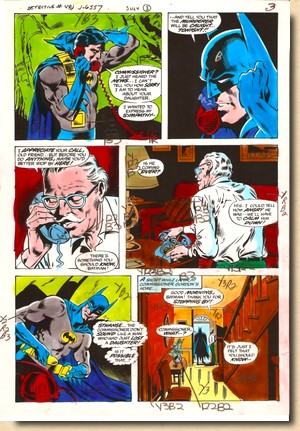 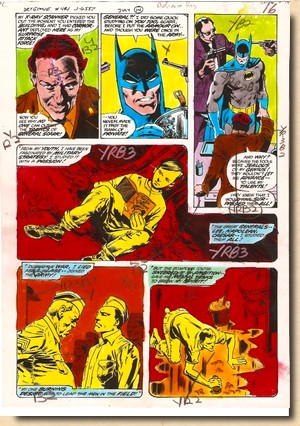
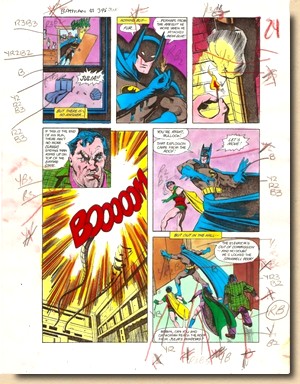
Top to bottom: colour proof
pages with additional CMYK codes by Adrienne Roy
from:
Detective Comics #492 page 3
Detective Comics #492 page 16
Batman #396 page 18
(scanned from the original
pages in personal collection)
|
|
| |
COMMENTS FROM THE BATCAVE
(from the pages of Detective
Comics #516)
|
| |
 |
|
"With
such a workload, it is amazing that Gerry
[Conway] manages to write such consistently good
stories. The "I of the Beholder" was
fabulous. You've got so many sub-plots going in
this book it's impossible to be uninterested in
the goings on." (Alfred Boutillier,
Barton MD)
"It was also very
good to see Don Newton, the master of the
Detective art, back. His art was perfect as
usual." (Dominec Romano, Toronto Ont.)
"Thank you and good
afternoon!" (Dick Giordano, editor)
|
| |
|
|
|

|
| |
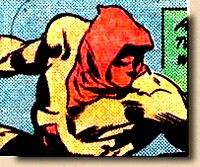 |
|
SPOTLIGHT
ON
MIRAGE
IDENTITY -
unknown
FIRST
APPEARANCE -
Detective Comics #511 (February
1982)
CREATED BY -
Gerry Conway & Don Newton
CHARACTERIZATION - Illusionist,
colourful but marginal villain with very
few appearances only
|
|
|
| |
ORIGIN & APPEARANCES
First
introduced in this issue of Detective Comics,
Mirage is a criminal whose identity remains unknown
throughout his first published encounter with Batman. He
uses a gem that causes people to see elaborate and
incredibly realistic illusions, although the exact
quality of the power contained within Mirage's gem is of
unknown and unexplained origin. Its functionality seems
to stem from visual and accoustic stimuli induced by
light and audio waves. Mirage then commits his crimes
whilst his victims are occupied struggling with - and
often fighting against - the illusions they believe they
are seeing for real.
|
| |
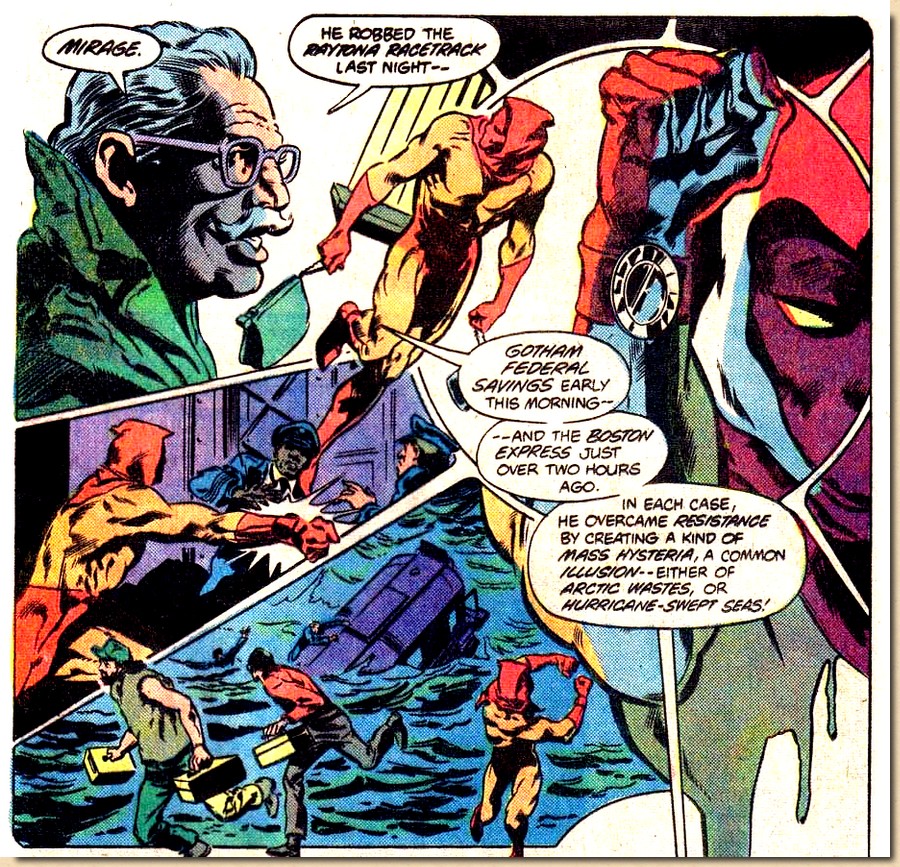 |
| |
| At the end of his
initial crime wave, Mirage is brought
down by a determined Batman who operates
with a special sound-blocking device and
his sheer willpower (when the device is
smashed up during the fight). During that
struggle Mirage remarks that "they
never covered this at the Academy! I
don't know what to do!" Mirage
ends up in prison. Not
followed up on in Detective Comics
#511, the meaning of these words is
revealed much later, in Batman:
Shadow of the Bat #15 (August 1993).
Mirage is now shown to be Kerry Austin
(sometimes also called Mike) who takes a
course at the Academy of Crime and starts
using illusions as a gimmicked
supervillain.
|
|
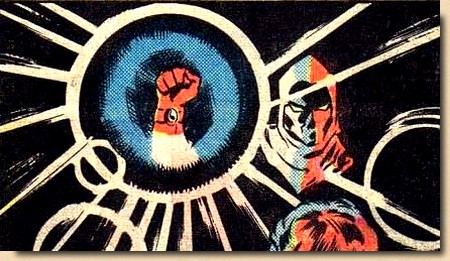 |
|
|
| |
| He is the
boyfriend of Gina Corolla with whom he performs a
hypnosis and illusion show act as The Mindbenders
at the Gotham Fun Fair. One day he finds a unique round
jewel and begins using it as a prop in the act, slowly
realising that the gem amplifies his thoughts and makes
his illusions seem so real hardly anyone can resist them. |
| |
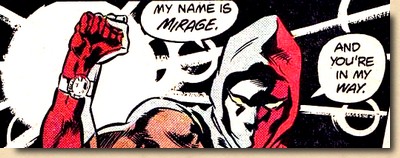
|
|
He decides to
become one of the costumed
criminals of Gotham City, wearing
a full face mask with a hood and
his all-important jewel mounted
in a bracelet on his right wrist.
He then
embarks on a crash course in the
fine art of villainy at the
Hollywood-based Academy of Crime.
It is upon his return to Gotham
City that the events told in Detective
Comics #511 then take place.
|
|
|
|
| |
| Following
the events of Infinite Crisis, Mirage was freed from
prison but then murdered by Intergang boss Bruno Mannheim
in 52 #25 - putting a final end to all of his
illusions. Reader feedback at the time shows
that Mirage was perceived to be an interesting villain,
but the potential of his modus operandi and his
visuals was never explored any further, neither by his
original creator Gerry Conway nor by any other DC writer,
so that instead he effectively became a throw-away
villain. Clearly falling into the category of illusionist
villains (iconically represented by Marvel's Mysterio and
DC's Scarecrow) he could have
become an interesting Batman antagonist, but just like
his illusions Mirage himself ultimately vanished. In
fact, DC even passed on the name as Marv Wolfman re-used
it in 1991 for a female Teen Titans character.
|
| |
| |
| BIBLIOGRAPHY EURY Michael
(2011) "Adrienne Roy Interview", in Back
Issue #51 (September 2011)
FERRY
Ervin Sidney (1921) General Physics and Its
Application to Industry and Everyday Life,
John Wiley & Sons
TOLLIN
Anthony (2010) DC
colorist Adrienne Roy: 1953-2010, published
online at cbgxtra.com
|
|
| |
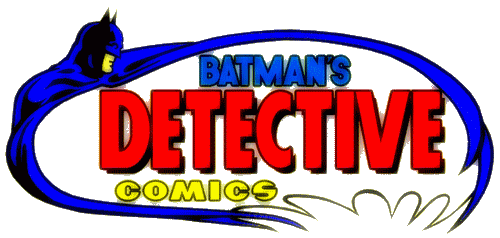
|
| |
| |
BATMAN and all
related elements are the property of DC Comics,
Inc. TM and © DC Comics, Inc., a subsidiary of
Time Warner Inc.
The illustrations presented here are copyright
material. Their reproduction for the review and
research purposes of this website is considered
fair use as set out by the Copyright Act of 1976,
17 U.S.C. par. 107.

uploaded to the web 27
December 2015
|
|
|




















